Baltimore, September 2007: VANET Challenges and Future Directions
VerifiedAdded on 2019/09/20
|16
|4385
|244
Literature Review
AI Summary
The provided content is a collection of research papers and articles related to vehicular ad-hoc networks (VANETs). The papers cover various aspects of VANETs, including routing protocols, security issues, and communication standards. Specific topics include Greedy Perimeter Stateless Routing, DSRC (Dedicated Short Range Communications) standards, IP address configuration in VANETs, and the Fleetnet project, which aimed to develop a position-aware ad-hoc wireless network for inter-vehicle communications.
Contribute Materials
Your contribution can guide someone’s learning journey. Share your
documents today.

Running Head: VEHICULA AD-HOC NETWORK
Vehicular Ad-Hoc Network: Current Challenges, and Future Perspective
Vehicular Ad-Hoc Network: Current Challenges, and Future Perspective
Secure Best Marks with AI Grader
Need help grading? Try our AI Grader for instant feedback on your assignments.
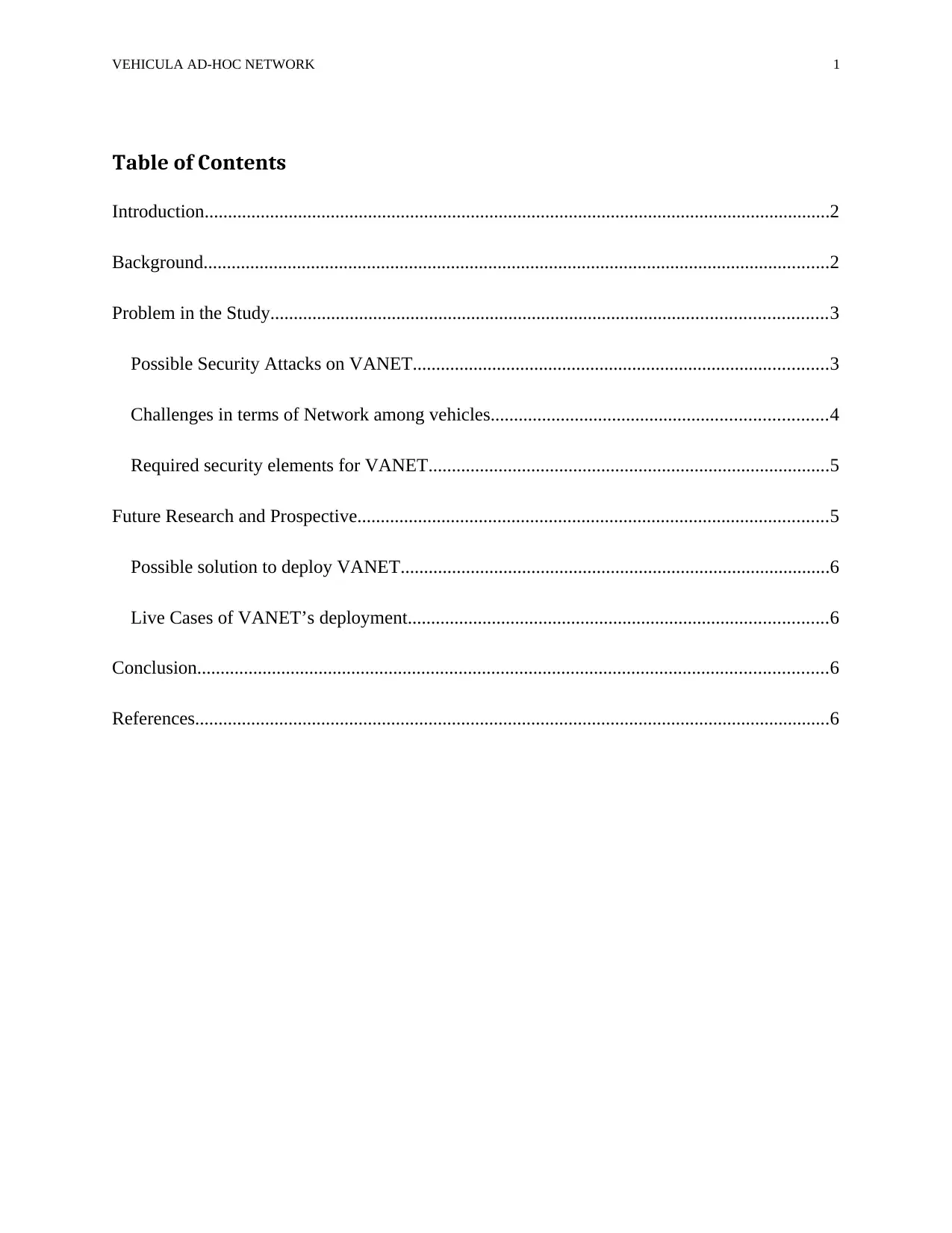
VEHICULA AD-HOC NETWORK 1
Table of Contents
Introduction......................................................................................................................................2
Background......................................................................................................................................2
Problem in the Study.......................................................................................................................3
Possible Security Attacks on VANET.........................................................................................3
Challenges in terms of Network among vehicles........................................................................4
Required security elements for VANET......................................................................................5
Future Research and Prospective.....................................................................................................5
Possible solution to deploy VANET............................................................................................6
Live Cases of VANET’s deployment..........................................................................................6
Conclusion.......................................................................................................................................6
References........................................................................................................................................6
Table of Contents
Introduction......................................................................................................................................2
Background......................................................................................................................................2
Problem in the Study.......................................................................................................................3
Possible Security Attacks on VANET.........................................................................................3
Challenges in terms of Network among vehicles........................................................................4
Required security elements for VANET......................................................................................5
Future Research and Prospective.....................................................................................................5
Possible solution to deploy VANET............................................................................................6
Live Cases of VANET’s deployment..........................................................................................6
Conclusion.......................................................................................................................................6
References........................................................................................................................................6
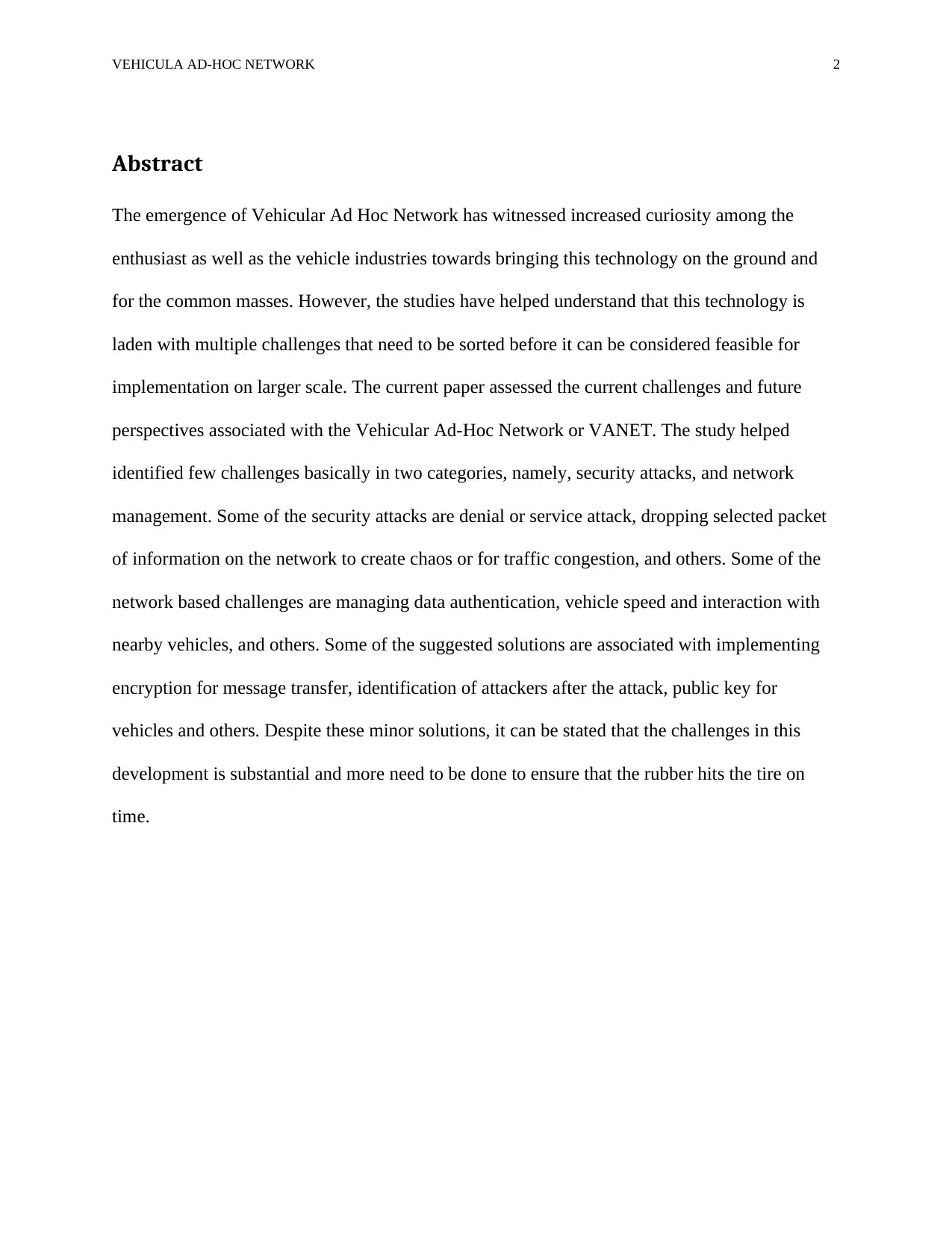
VEHICULA AD-HOC NETWORK 2
Abstract
The emergence of Vehicular Ad Hoc Network has witnessed increased curiosity among the
enthusiast as well as the vehicle industries towards bringing this technology on the ground and
for the common masses. However, the studies have helped understand that this technology is
laden with multiple challenges that need to be sorted before it can be considered feasible for
implementation on larger scale. The current paper assessed the current challenges and future
perspectives associated with the Vehicular Ad-Hoc Network or VANET. The study helped
identified few challenges basically in two categories, namely, security attacks, and network
management. Some of the security attacks are denial or service attack, dropping selected packet
of information on the network to create chaos or for traffic congestion, and others. Some of the
network based challenges are managing data authentication, vehicle speed and interaction with
nearby vehicles, and others. Some of the suggested solutions are associated with implementing
encryption for message transfer, identification of attackers after the attack, public key for
vehicles and others. Despite these minor solutions, it can be stated that the challenges in this
development is substantial and more need to be done to ensure that the rubber hits the tire on
time.
Abstract
The emergence of Vehicular Ad Hoc Network has witnessed increased curiosity among the
enthusiast as well as the vehicle industries towards bringing this technology on the ground and
for the common masses. However, the studies have helped understand that this technology is
laden with multiple challenges that need to be sorted before it can be considered feasible for
implementation on larger scale. The current paper assessed the current challenges and future
perspectives associated with the Vehicular Ad-Hoc Network or VANET. The study helped
identified few challenges basically in two categories, namely, security attacks, and network
management. Some of the security attacks are denial or service attack, dropping selected packet
of information on the network to create chaos or for traffic congestion, and others. Some of the
network based challenges are managing data authentication, vehicle speed and interaction with
nearby vehicles, and others. Some of the suggested solutions are associated with implementing
encryption for message transfer, identification of attackers after the attack, public key for
vehicles and others. Despite these minor solutions, it can be stated that the challenges in this
development is substantial and more need to be done to ensure that the rubber hits the tire on
time.

VEHICULA AD-HOC NETWORK 3
Introduction
With the increase in the technological advancements and the decrease in the costs of electronic
components, the manufacturers have oriented towards introducing new things in their vehicles.
One such component is the Vehicular Ad-hoc Network (VANet). Now the manufacturers are
moving faster towards building vehicles that can communicate with each other on the road and
become automated or, in other word, driver less (Raya & Hubaux, 2005).
Various initiatives are being taken to consider the introduction of VANET based vehicles for the
actual passengers. However, it has been observed that this technology is facing multiple
challenges in terms of security. These security challenges are making the instant application of
this technology less plausible (Junyuan et al, 2007). The vehicular communication brings huge
opportunity in terms of increase in the safety, reduction in traffic, reduction in the road accidents,
and others (Harsch et al, 2007).
The current paper is concerned with investigating the various aspects associated with the
vehicular ad-hoc network to understand whether the system can be implemented for the general
public. Moreover, the focus will be to gain brief understanding of this technology along with the
various security challenges posed by it.
The paper has been divided into three key sections. The first is the background, where the focus
would be to understand the technology in brief and the need for the study. The second section is
focused on understanding the problems associated with the security aspects of VANET. The
third section is concerned with understanding whether there are ways to handle the security
challenges and make the system implementable for the masses.
Introduction
With the increase in the technological advancements and the decrease in the costs of electronic
components, the manufacturers have oriented towards introducing new things in their vehicles.
One such component is the Vehicular Ad-hoc Network (VANet). Now the manufacturers are
moving faster towards building vehicles that can communicate with each other on the road and
become automated or, in other word, driver less (Raya & Hubaux, 2005).
Various initiatives are being taken to consider the introduction of VANET based vehicles for the
actual passengers. However, it has been observed that this technology is facing multiple
challenges in terms of security. These security challenges are making the instant application of
this technology less plausible (Junyuan et al, 2007). The vehicular communication brings huge
opportunity in terms of increase in the safety, reduction in traffic, reduction in the road accidents,
and others (Harsch et al, 2007).
The current paper is concerned with investigating the various aspects associated with the
vehicular ad-hoc network to understand whether the system can be implemented for the general
public. Moreover, the focus will be to gain brief understanding of this technology along with the
various security challenges posed by it.
The paper has been divided into three key sections. The first is the background, where the focus
would be to understand the technology in brief and the need for the study. The second section is
focused on understanding the problems associated with the security aspects of VANET. The
third section is concerned with understanding whether there are ways to handle the security
challenges and make the system implementable for the masses.
Paraphrase This Document
Need a fresh take? Get an instant paraphrase of this document with our AI Paraphraser
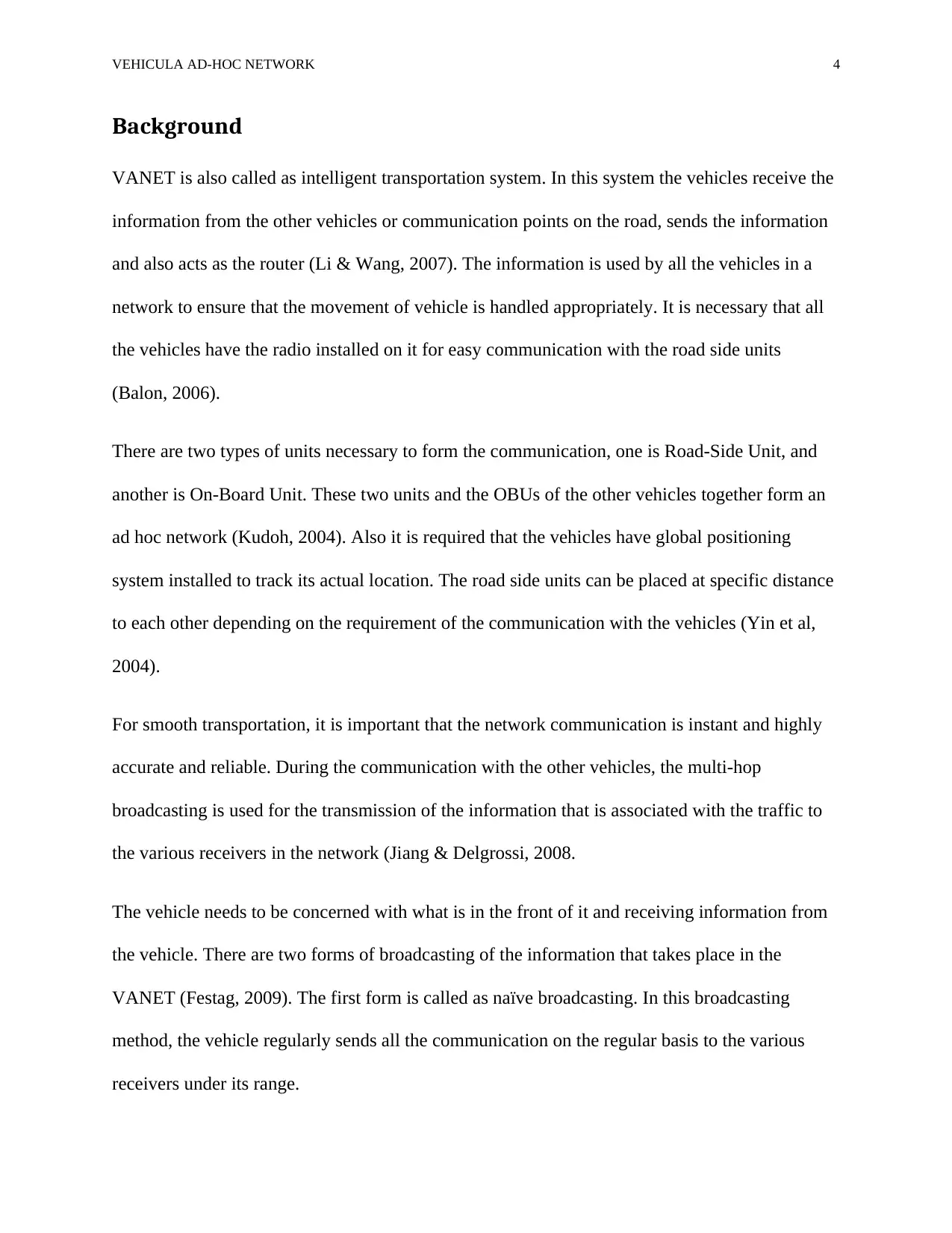
VEHICULA AD-HOC NETWORK 4
Background
VANET is also called as intelligent transportation system. In this system the vehicles receive the
information from the other vehicles or communication points on the road, sends the information
and also acts as the router (Li & Wang, 2007). The information is used by all the vehicles in a
network to ensure that the movement of vehicle is handled appropriately. It is necessary that all
the vehicles have the radio installed on it for easy communication with the road side units
(Balon, 2006).
There are two types of units necessary to form the communication, one is Road-Side Unit, and
another is On-Board Unit. These two units and the OBUs of the other vehicles together form an
ad hoc network (Kudoh, 2004). Also it is required that the vehicles have global positioning
system installed to track its actual location. The road side units can be placed at specific distance
to each other depending on the requirement of the communication with the vehicles (Yin et al,
2004).
For smooth transportation, it is important that the network communication is instant and highly
accurate and reliable. During the communication with the other vehicles, the multi-hop
broadcasting is used for the transmission of the information that is associated with the traffic to
the various receivers in the network (Jiang & Delgrossi, 2008.
The vehicle needs to be concerned with what is in the front of it and receiving information from
the vehicle. There are two forms of broadcasting of the information that takes place in the
VANET (Festag, 2009). The first form is called as naïve broadcasting. In this broadcasting
method, the vehicle regularly sends all the communication on the regular basis to the various
receivers under its range.
Background
VANET is also called as intelligent transportation system. In this system the vehicles receive the
information from the other vehicles or communication points on the road, sends the information
and also acts as the router (Li & Wang, 2007). The information is used by all the vehicles in a
network to ensure that the movement of vehicle is handled appropriately. It is necessary that all
the vehicles have the radio installed on it for easy communication with the road side units
(Balon, 2006).
There are two types of units necessary to form the communication, one is Road-Side Unit, and
another is On-Board Unit. These two units and the OBUs of the other vehicles together form an
ad hoc network (Kudoh, 2004). Also it is required that the vehicles have global positioning
system installed to track its actual location. The road side units can be placed at specific distance
to each other depending on the requirement of the communication with the vehicles (Yin et al,
2004).
For smooth transportation, it is important that the network communication is instant and highly
accurate and reliable. During the communication with the other vehicles, the multi-hop
broadcasting is used for the transmission of the information that is associated with the traffic to
the various receivers in the network (Jiang & Delgrossi, 2008.
The vehicle needs to be concerned with what is in the front of it and receiving information from
the vehicle. There are two forms of broadcasting of the information that takes place in the
VANET (Festag, 2009). The first form is called as naïve broadcasting. In this broadcasting
method, the vehicle regularly sends all the communication on the regular basis to the various
receivers under its range.
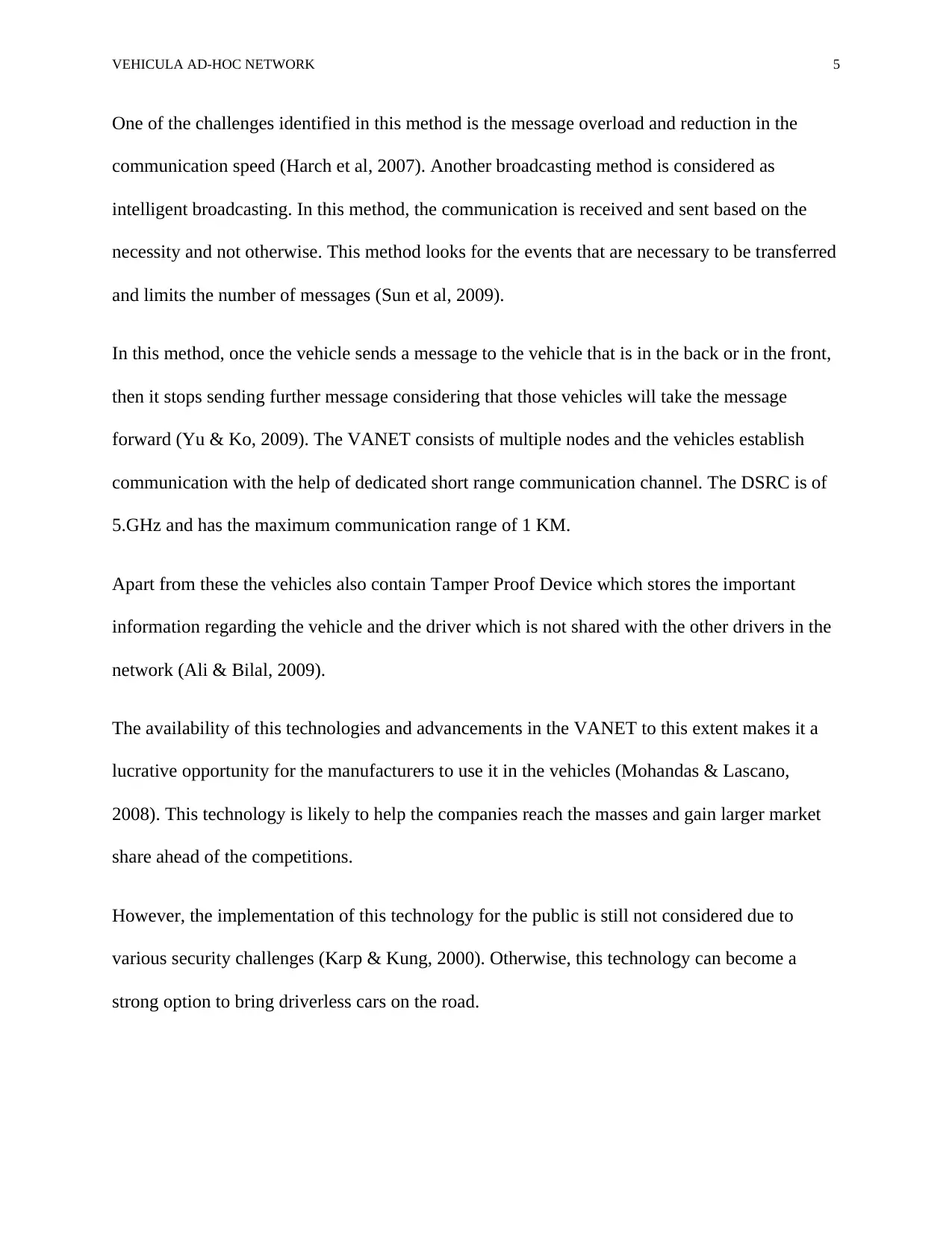
VEHICULA AD-HOC NETWORK 5
One of the challenges identified in this method is the message overload and reduction in the
communication speed (Harch et al, 2007). Another broadcasting method is considered as
intelligent broadcasting. In this method, the communication is received and sent based on the
necessity and not otherwise. This method looks for the events that are necessary to be transferred
and limits the number of messages (Sun et al, 2009).
In this method, once the vehicle sends a message to the vehicle that is in the back or in the front,
then it stops sending further message considering that those vehicles will take the message
forward (Yu & Ko, 2009). The VANET consists of multiple nodes and the vehicles establish
communication with the help of dedicated short range communication channel. The DSRC is of
5.GHz and has the maximum communication range of 1 KM.
Apart from these the vehicles also contain Tamper Proof Device which stores the important
information regarding the vehicle and the driver which is not shared with the other drivers in the
network (Ali & Bilal, 2009).
The availability of this technologies and advancements in the VANET to this extent makes it a
lucrative opportunity for the manufacturers to use it in the vehicles (Mohandas & Lascano,
2008). This technology is likely to help the companies reach the masses and gain larger market
share ahead of the competitions.
However, the implementation of this technology for the public is still not considered due to
various security challenges (Karp & Kung, 2000). Otherwise, this technology can become a
strong option to bring driverless cars on the road.
One of the challenges identified in this method is the message overload and reduction in the
communication speed (Harch et al, 2007). Another broadcasting method is considered as
intelligent broadcasting. In this method, the communication is received and sent based on the
necessity and not otherwise. This method looks for the events that are necessary to be transferred
and limits the number of messages (Sun et al, 2009).
In this method, once the vehicle sends a message to the vehicle that is in the back or in the front,
then it stops sending further message considering that those vehicles will take the message
forward (Yu & Ko, 2009). The VANET consists of multiple nodes and the vehicles establish
communication with the help of dedicated short range communication channel. The DSRC is of
5.GHz and has the maximum communication range of 1 KM.
Apart from these the vehicles also contain Tamper Proof Device which stores the important
information regarding the vehicle and the driver which is not shared with the other drivers in the
network (Ali & Bilal, 2009).
The availability of this technologies and advancements in the VANET to this extent makes it a
lucrative opportunity for the manufacturers to use it in the vehicles (Mohandas & Lascano,
2008). This technology is likely to help the companies reach the masses and gain larger market
share ahead of the competitions.
However, the implementation of this technology for the public is still not considered due to
various security challenges (Karp & Kung, 2000). Otherwise, this technology can become a
strong option to bring driverless cars on the road.

VEHICULA AD-HOC NETWORK 6
Problem in the Study
In this section, the focus is on understanding the various cyber-security challenges that are
preventing this system to go live for the general public. There are three aspects that have been
discussed. They are security attacks, network challenges, and security requirements.
Possible Security Attacks on VANET
The first kind of security attack identified for the VANET is the DoS attack. The Denial of
Service attack states that it is possible that due to the external transference, the information from
one vehicle can be blocked from reaching the other (Blum & Eskandarian, 2006). The
individuals with malicious intent may try to attack the system with the DoS attack. Few of the
researchers have suggested using multiple channel of communication during transportation to
ensure that if one fails, then other can take over (Hartenstein et al, 2001).
However, there has been no practical testing of this suggestion. Another form of attack is
dropping selected packets of information from the network. If such packets contain information
that are key for the receivers to know in order to identify the vehicle or the current state of the
vehicle (Yang et al, 2007). This attack can be taken with the intention to hide any expired
insurance or pollution check report from the security personnel.
Another instance can be hiding the congested traffic information from the vehicles and forcing
the vehicles to stay stuck in the traffic.
The attacker can also send information to the network that is not true. The false information
dissemination can be done by the attacker to send wrong messages or any false warning. The
attacker can also pose as someone else. Another form of attach is when the attacker changes the
current data or makes effort to change the actual stored data in the system (Biswas et al, 2006).
Problem in the Study
In this section, the focus is on understanding the various cyber-security challenges that are
preventing this system to go live for the general public. There are three aspects that have been
discussed. They are security attacks, network challenges, and security requirements.
Possible Security Attacks on VANET
The first kind of security attack identified for the VANET is the DoS attack. The Denial of
Service attack states that it is possible that due to the external transference, the information from
one vehicle can be blocked from reaching the other (Blum & Eskandarian, 2006). The
individuals with malicious intent may try to attack the system with the DoS attack. Few of the
researchers have suggested using multiple channel of communication during transportation to
ensure that if one fails, then other can take over (Hartenstein et al, 2001).
However, there has been no practical testing of this suggestion. Another form of attack is
dropping selected packets of information from the network. If such packets contain information
that are key for the receivers to know in order to identify the vehicle or the current state of the
vehicle (Yang et al, 2007). This attack can be taken with the intention to hide any expired
insurance or pollution check report from the security personnel.
Another instance can be hiding the congested traffic information from the vehicles and forcing
the vehicles to stay stuck in the traffic.
The attacker can also send information to the network that is not true. The false information
dissemination can be done by the attacker to send wrong messages or any false warning. The
attacker can also pose as someone else. Another form of attach is when the attacker changes the
current data or makes effort to change the actual stored data in the system (Biswas et al, 2006).
Secure Best Marks with AI Grader
Need help grading? Try our AI Grader for instant feedback on your assignments.
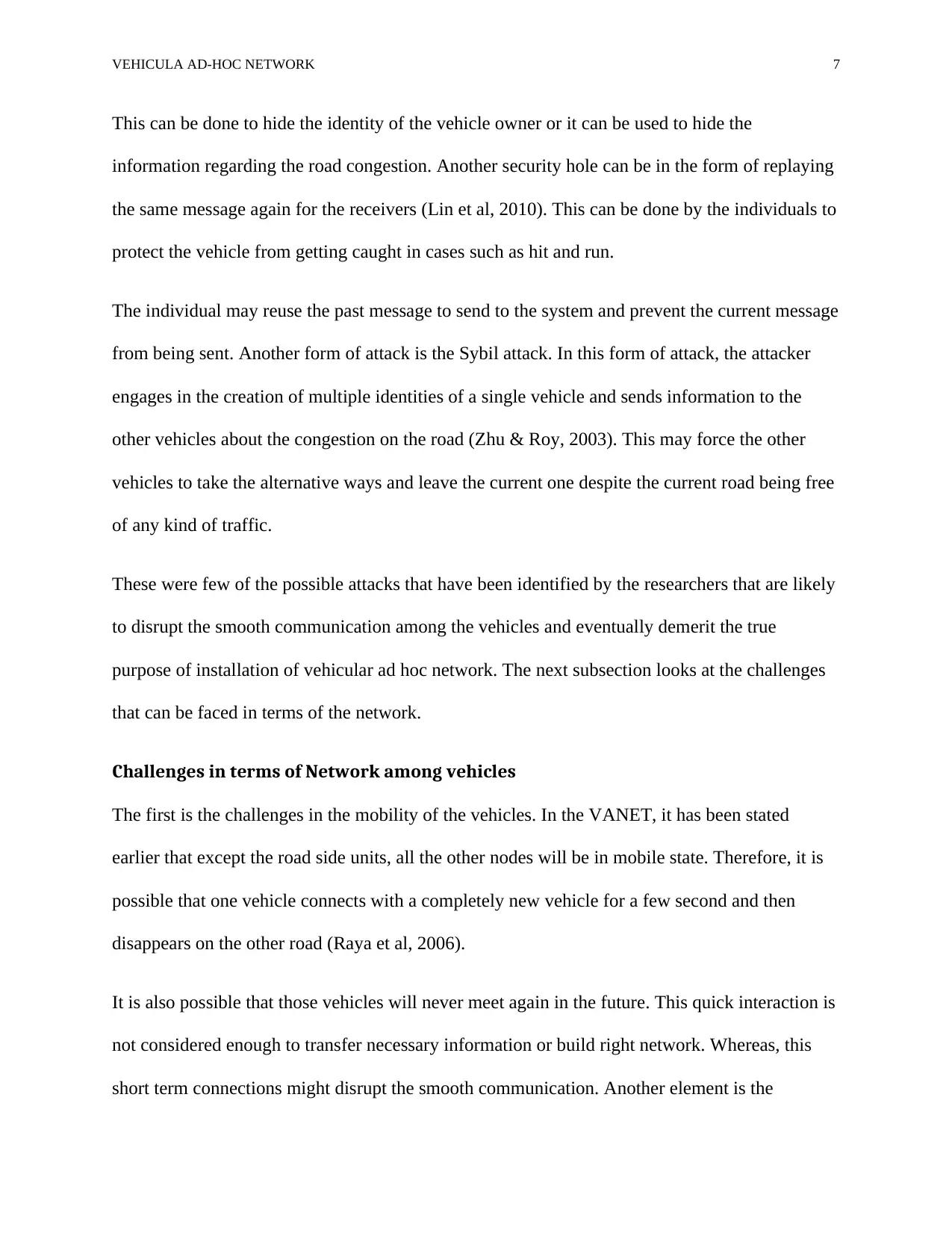
VEHICULA AD-HOC NETWORK 7
This can be done to hide the identity of the vehicle owner or it can be used to hide the
information regarding the road congestion. Another security hole can be in the form of replaying
the same message again for the receivers (Lin et al, 2010). This can be done by the individuals to
protect the vehicle from getting caught in cases such as hit and run.
The individual may reuse the past message to send to the system and prevent the current message
from being sent. Another form of attack is the Sybil attack. In this form of attack, the attacker
engages in the creation of multiple identities of a single vehicle and sends information to the
other vehicles about the congestion on the road (Zhu & Roy, 2003). This may force the other
vehicles to take the alternative ways and leave the current one despite the current road being free
of any kind of traffic.
These were few of the possible attacks that have been identified by the researchers that are likely
to disrupt the smooth communication among the vehicles and eventually demerit the true
purpose of installation of vehicular ad hoc network. The next subsection looks at the challenges
that can be faced in terms of the network.
Challenges in terms of Network among vehicles
The first is the challenges in the mobility of the vehicles. In the VANET, it has been stated
earlier that except the road side units, all the other nodes will be in mobile state. Therefore, it is
possible that one vehicle connects with a completely new vehicle for a few second and then
disappears on the other road (Raya et al, 2006).
It is also possible that those vehicles will never meet again in the future. This quick interaction is
not considered enough to transfer necessary information or build right network. Whereas, this
short term connections might disrupt the smooth communication. Another element is the
This can be done to hide the identity of the vehicle owner or it can be used to hide the
information regarding the road congestion. Another security hole can be in the form of replaying
the same message again for the receivers (Lin et al, 2010). This can be done by the individuals to
protect the vehicle from getting caught in cases such as hit and run.
The individual may reuse the past message to send to the system and prevent the current message
from being sent. Another form of attack is the Sybil attack. In this form of attack, the attacker
engages in the creation of multiple identities of a single vehicle and sends information to the
other vehicles about the congestion on the road (Zhu & Roy, 2003). This may force the other
vehicles to take the alternative ways and leave the current one despite the current road being free
of any kind of traffic.
These were few of the possible attacks that have been identified by the researchers that are likely
to disrupt the smooth communication among the vehicles and eventually demerit the true
purpose of installation of vehicular ad hoc network. The next subsection looks at the challenges
that can be faced in terms of the network.
Challenges in terms of Network among vehicles
The first is the challenges in the mobility of the vehicles. In the VANET, it has been stated
earlier that except the road side units, all the other nodes will be in mobile state. Therefore, it is
possible that one vehicle connects with a completely new vehicle for a few second and then
disappears on the other road (Raya et al, 2006).
It is also possible that those vehicles will never meet again in the future. This quick interaction is
not considered enough to transfer necessary information or build right network. Whereas, this
short term connections might disrupt the smooth communication. Another element is the

VEHICULA AD-HOC NETWORK 8
volatility of the connection among the nodes. It is possible that the vehicle is travelling at the
greater speed and might not establish strong connection required for better data transfer
(Shulman & Deering, 2007). In the case of one way transportation, it will not have major issue,
however, in the two way or multi-way roads, the vehicles will cross each other at high speed and
therefore establishing a secure network at that speed will be difficult.
This will bring high level of volatility in the network. Moreover, it would not be feasible to save
the password for each vehicle to the wifi network. The reason is that the vehicles are not likely to
traverse the same path every time and therefore the storage of such information is not considered
a practical step (Reichardt, 2002).
Another challenging element is the scalability of the network. The presence of vehicles is
growing day after day and it has reached around a billion. In addition, there are no global
authorities that can monitor the communication among all the vehicles. The lack of any global
authority and the free dissemination of vehicle information over the network may pose a serious
threat to the personal information in the long run.
Other than this, one challenge is associated with the presence of radios with the vehicles
travelling on the road. At present, it is possible that high number of vehicles does not have the
radios and other equipment required for the intelligent transportation (Tsugawa, 2000).
Therefore, in the initial phase of the implementation, it has to be kept in consideration that large
number of the vehicle will not have this system.
Also, it makes the easy implementation challenging. Moreover, if the financial firms do not see
any long term benefit in this technology, then there is likeliness that they will not bring the right
amount of investment and projects may not takeoff as expected.
volatility of the connection among the nodes. It is possible that the vehicle is travelling at the
greater speed and might not establish strong connection required for better data transfer
(Shulman & Deering, 2007). In the case of one way transportation, it will not have major issue,
however, in the two way or multi-way roads, the vehicles will cross each other at high speed and
therefore establishing a secure network at that speed will be difficult.
This will bring high level of volatility in the network. Moreover, it would not be feasible to save
the password for each vehicle to the wifi network. The reason is that the vehicles are not likely to
traverse the same path every time and therefore the storage of such information is not considered
a practical step (Reichardt, 2002).
Another challenging element is the scalability of the network. The presence of vehicles is
growing day after day and it has reached around a billion. In addition, there are no global
authorities that can monitor the communication among all the vehicles. The lack of any global
authority and the free dissemination of vehicle information over the network may pose a serious
threat to the personal information in the long run.
Other than this, one challenge is associated with the presence of radios with the vehicles
travelling on the road. At present, it is possible that high number of vehicles does not have the
radios and other equipment required for the intelligent transportation (Tsugawa, 2000).
Therefore, in the initial phase of the implementation, it has to be kept in consideration that large
number of the vehicle will not have this system.
Also, it makes the easy implementation challenging. Moreover, if the financial firms do not see
any long term benefit in this technology, then there is likeliness that they will not bring the right
amount of investment and projects may not takeoff as expected.
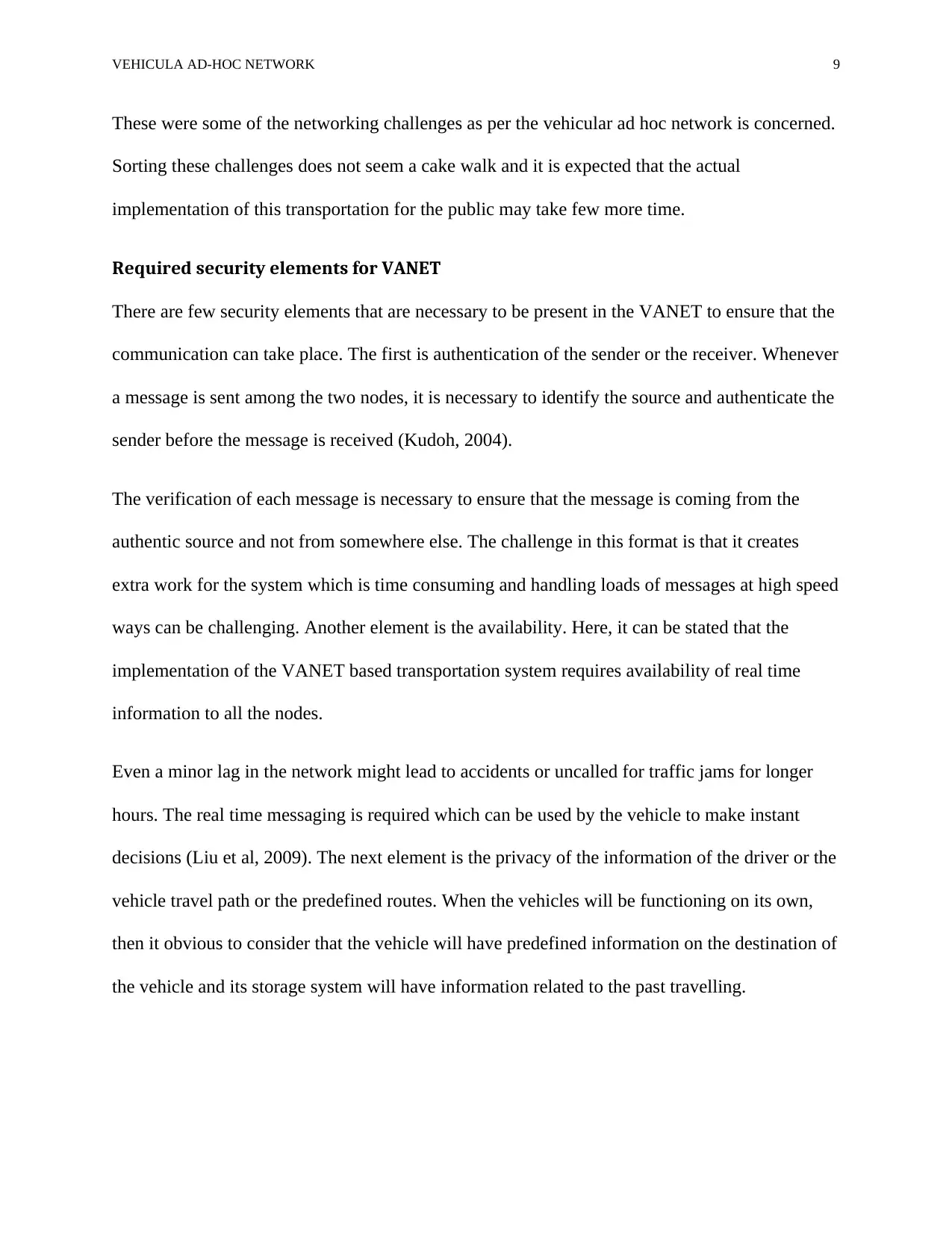
VEHICULA AD-HOC NETWORK 9
These were some of the networking challenges as per the vehicular ad hoc network is concerned.
Sorting these challenges does not seem a cake walk and it is expected that the actual
implementation of this transportation for the public may take few more time.
Required security elements for VANET
There are few security elements that are necessary to be present in the VANET to ensure that the
communication can take place. The first is authentication of the sender or the receiver. Whenever
a message is sent among the two nodes, it is necessary to identify the source and authenticate the
sender before the message is received (Kudoh, 2004).
The verification of each message is necessary to ensure that the message is coming from the
authentic source and not from somewhere else. The challenge in this format is that it creates
extra work for the system which is time consuming and handling loads of messages at high speed
ways can be challenging. Another element is the availability. Here, it can be stated that the
implementation of the VANET based transportation system requires availability of real time
information to all the nodes.
Even a minor lag in the network might lead to accidents or uncalled for traffic jams for longer
hours. The real time messaging is required which can be used by the vehicle to make instant
decisions (Liu et al, 2009). The next element is the privacy of the information of the driver or the
vehicle travel path or the predefined routes. When the vehicles will be functioning on its own,
then it obvious to consider that the vehicle will have predefined information on the destination of
the vehicle and its storage system will have information related to the past travelling.
These were some of the networking challenges as per the vehicular ad hoc network is concerned.
Sorting these challenges does not seem a cake walk and it is expected that the actual
implementation of this transportation for the public may take few more time.
Required security elements for VANET
There are few security elements that are necessary to be present in the VANET to ensure that the
communication can take place. The first is authentication of the sender or the receiver. Whenever
a message is sent among the two nodes, it is necessary to identify the source and authenticate the
sender before the message is received (Kudoh, 2004).
The verification of each message is necessary to ensure that the message is coming from the
authentic source and not from somewhere else. The challenge in this format is that it creates
extra work for the system which is time consuming and handling loads of messages at high speed
ways can be challenging. Another element is the availability. Here, it can be stated that the
implementation of the VANET based transportation system requires availability of real time
information to all the nodes.
Even a minor lag in the network might lead to accidents or uncalled for traffic jams for longer
hours. The real time messaging is required which can be used by the vehicle to make instant
decisions (Liu et al, 2009). The next element is the privacy of the information of the driver or the
vehicle travel path or the predefined routes. When the vehicles will be functioning on its own,
then it obvious to consider that the vehicle will have predefined information on the destination of
the vehicle and its storage system will have information related to the past travelling.
Paraphrase This Document
Need a fresh take? Get an instant paraphrase of this document with our AI Paraphraser
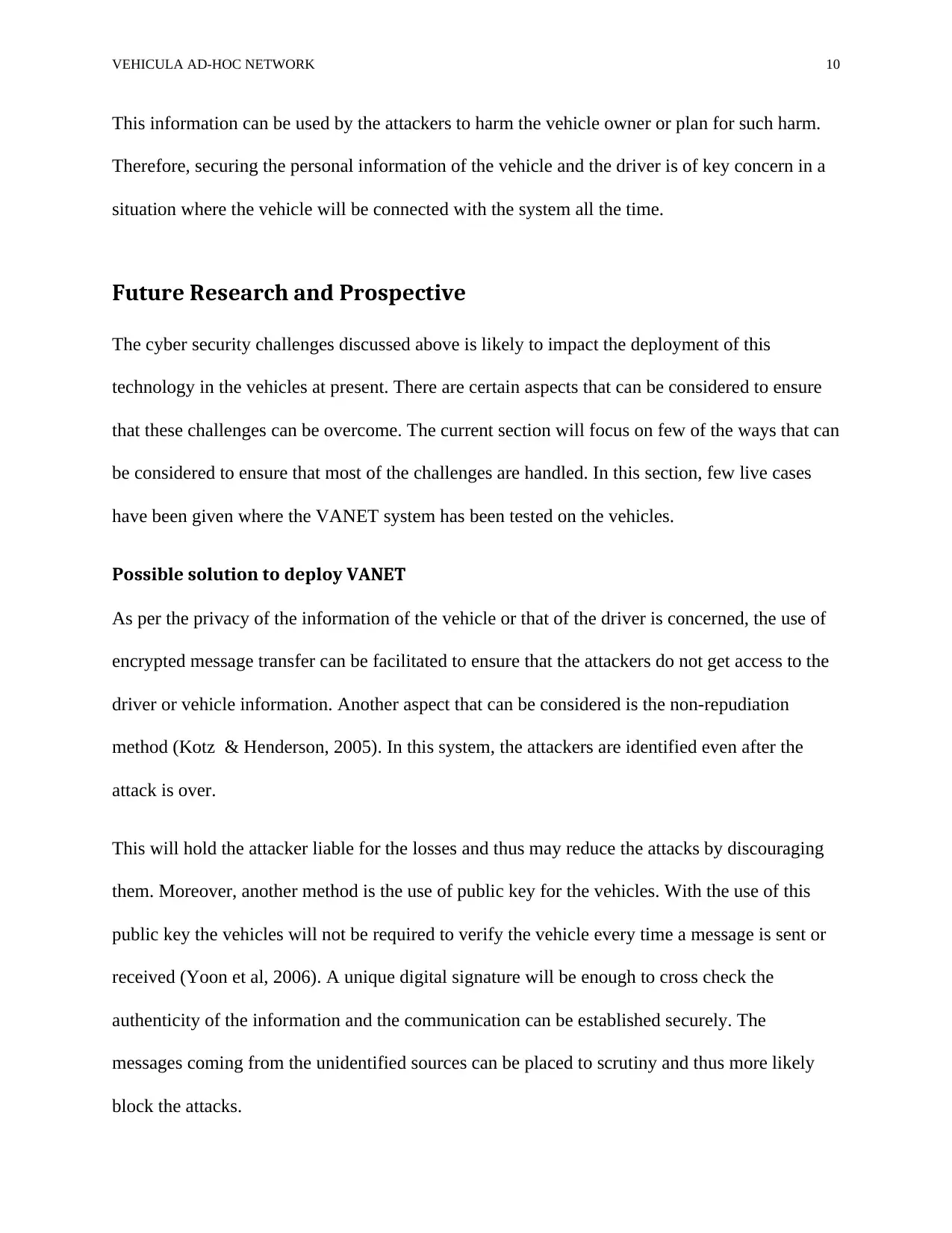
VEHICULA AD-HOC NETWORK 10
This information can be used by the attackers to harm the vehicle owner or plan for such harm.
Therefore, securing the personal information of the vehicle and the driver is of key concern in a
situation where the vehicle will be connected with the system all the time.
Future Research and Prospective
The cyber security challenges discussed above is likely to impact the deployment of this
technology in the vehicles at present. There are certain aspects that can be considered to ensure
that these challenges can be overcome. The current section will focus on few of the ways that can
be considered to ensure that most of the challenges are handled. In this section, few live cases
have been given where the VANET system has been tested on the vehicles.
Possible solution to deploy VANET
As per the privacy of the information of the vehicle or that of the driver is concerned, the use of
encrypted message transfer can be facilitated to ensure that the attackers do not get access to the
driver or vehicle information. Another aspect that can be considered is the non-repudiation
method (Kotz & Henderson, 2005). In this system, the attackers are identified even after the
attack is over.
This will hold the attacker liable for the losses and thus may reduce the attacks by discouraging
them. Moreover, another method is the use of public key for the vehicles. With the use of this
public key the vehicles will not be required to verify the vehicle every time a message is sent or
received (Yoon et al, 2006). A unique digital signature will be enough to cross check the
authenticity of the information and the communication can be established securely. The
messages coming from the unidentified sources can be placed to scrutiny and thus more likely
block the attacks.
This information can be used by the attackers to harm the vehicle owner or plan for such harm.
Therefore, securing the personal information of the vehicle and the driver is of key concern in a
situation where the vehicle will be connected with the system all the time.
Future Research and Prospective
The cyber security challenges discussed above is likely to impact the deployment of this
technology in the vehicles at present. There are certain aspects that can be considered to ensure
that these challenges can be overcome. The current section will focus on few of the ways that can
be considered to ensure that most of the challenges are handled. In this section, few live cases
have been given where the VANET system has been tested on the vehicles.
Possible solution to deploy VANET
As per the privacy of the information of the vehicle or that of the driver is concerned, the use of
encrypted message transfer can be facilitated to ensure that the attackers do not get access to the
driver or vehicle information. Another aspect that can be considered is the non-repudiation
method (Kotz & Henderson, 2005). In this system, the attackers are identified even after the
attack is over.
This will hold the attacker liable for the losses and thus may reduce the attacks by discouraging
them. Moreover, another method is the use of public key for the vehicles. With the use of this
public key the vehicles will not be required to verify the vehicle every time a message is sent or
received (Yoon et al, 2006). A unique digital signature will be enough to cross check the
authenticity of the information and the communication can be established securely. The
messages coming from the unidentified sources can be placed to scrutiny and thus more likely
block the attacks.

VEHICULA AD-HOC NETWORK 11
Live Cases of VANET’s deployment
There were few trials that took place in various locations around the world regarding the
VANET in US, Japan, and Europe. The VSC ran few trials by coordinating with the Highway
Traffic Safety in the US which helped them understand minimum system requirement to run the
vehicle, and the locations where the nodes to be placed for appropriate communication. This
testing was done between 1998 and 2004 (“United States. National Highway Traffic Safety
Administration”, 1997). Another testing was done in the Europe by Car2Car Communications.
The system was focused towards assisting the drivers through wireless technology and
developing safety modules.
Conclusion
The assessment of the various research paper led to the understanding that though VANET has
the huge potential for the transportation but it also contains huge challenges in terms of security.
The appropriate consideration of all the cyber security challenges and handling them properly is
the only way that can help the system hit the road for the public.
After the assessment of the paper, it has been considered that the major challenges are considered
on the external front, that is, the attacks on the system from the outside. This study can be
considered as the base for the further study in this area to identify the possible solutions to these
challenges. More studies can be unearthed to understand possible solutions in the future.
Live Cases of VANET’s deployment
There were few trials that took place in various locations around the world regarding the
VANET in US, Japan, and Europe. The VSC ran few trials by coordinating with the Highway
Traffic Safety in the US which helped them understand minimum system requirement to run the
vehicle, and the locations where the nodes to be placed for appropriate communication. This
testing was done between 1998 and 2004 (“United States. National Highway Traffic Safety
Administration”, 1997). Another testing was done in the Europe by Car2Car Communications.
The system was focused towards assisting the drivers through wireless technology and
developing safety modules.
Conclusion
The assessment of the various research paper led to the understanding that though VANET has
the huge potential for the transportation but it also contains huge challenges in terms of security.
The appropriate consideration of all the cyber security challenges and handling them properly is
the only way that can help the system hit the road for the public.
After the assessment of the paper, it has been considered that the major challenges are considered
on the external front, that is, the attacks on the system from the outside. This study can be
considered as the base for the further study in this area to identify the possible solutions to these
challenges. More studies can be unearthed to understand possible solutions in the future.
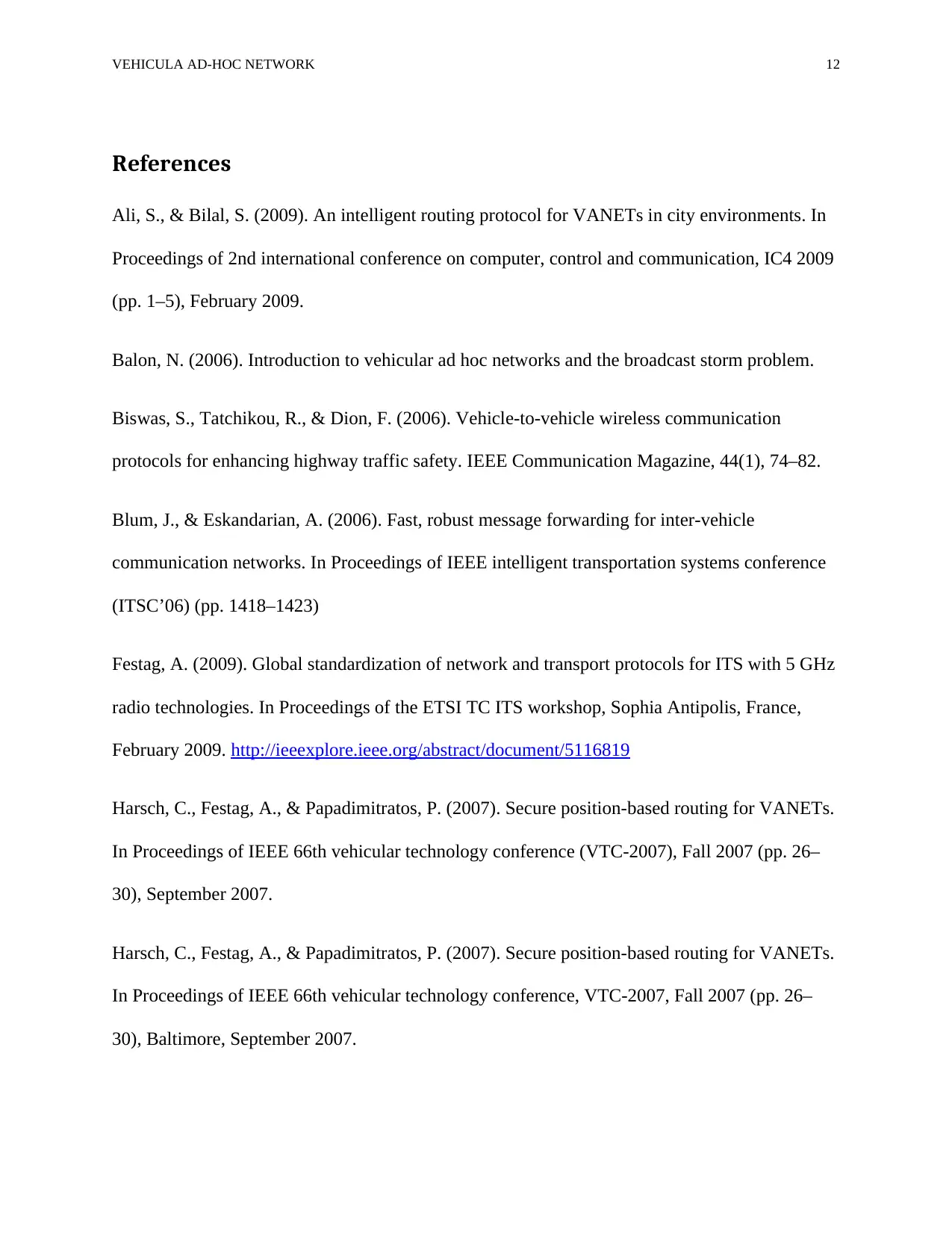
VEHICULA AD-HOC NETWORK 12
References
Ali, S., & Bilal, S. (2009). An intelligent routing protocol for VANETs in city environments. In
Proceedings of 2nd international conference on computer, control and communication, IC4 2009
(pp. 1–5), February 2009.
Balon, N. (2006). Introduction to vehicular ad hoc networks and the broadcast storm problem.
Biswas, S., Tatchikou, R., & Dion, F. (2006). Vehicle-to-vehicle wireless communication
protocols for enhancing highway traffic safety. IEEE Communication Magazine, 44(1), 74–82.
Blum, J., & Eskandarian, A. (2006). Fast, robust message forwarding for inter-vehicle
communication networks. In Proceedings of IEEE intelligent transportation systems conference
(ITSC’06) (pp. 1418–1423)
Festag, A. (2009). Global standardization of network and transport protocols for ITS with 5 GHz
radio technologies. In Proceedings of the ETSI TC ITS workshop, Sophia Antipolis, France,
February 2009. http://ieeexplore.ieee.org/abstract/document/5116819
Harsch, C., Festag, A., & Papadimitratos, P. (2007). Secure position-based routing for VANETs.
In Proceedings of IEEE 66th vehicular technology conference (VTC-2007), Fall 2007 (pp. 26–
30), September 2007.
Harsch, C., Festag, A., & Papadimitratos, P. (2007). Secure position-based routing for VANETs.
In Proceedings of IEEE 66th vehicular technology conference, VTC-2007, Fall 2007 (pp. 26–
30), Baltimore, September 2007.
References
Ali, S., & Bilal, S. (2009). An intelligent routing protocol for VANETs in city environments. In
Proceedings of 2nd international conference on computer, control and communication, IC4 2009
(pp. 1–5), February 2009.
Balon, N. (2006). Introduction to vehicular ad hoc networks and the broadcast storm problem.
Biswas, S., Tatchikou, R., & Dion, F. (2006). Vehicle-to-vehicle wireless communication
protocols for enhancing highway traffic safety. IEEE Communication Magazine, 44(1), 74–82.
Blum, J., & Eskandarian, A. (2006). Fast, robust message forwarding for inter-vehicle
communication networks. In Proceedings of IEEE intelligent transportation systems conference
(ITSC’06) (pp. 1418–1423)
Festag, A. (2009). Global standardization of network and transport protocols for ITS with 5 GHz
radio technologies. In Proceedings of the ETSI TC ITS workshop, Sophia Antipolis, France,
February 2009. http://ieeexplore.ieee.org/abstract/document/5116819
Harsch, C., Festag, A., & Papadimitratos, P. (2007). Secure position-based routing for VANETs.
In Proceedings of IEEE 66th vehicular technology conference (VTC-2007), Fall 2007 (pp. 26–
30), September 2007.
Harsch, C., Festag, A., & Papadimitratos, P. (2007). Secure position-based routing for VANETs.
In Proceedings of IEEE 66th vehicular technology conference, VTC-2007, Fall 2007 (pp. 26–
30), Baltimore, September 2007.
Secure Best Marks with AI Grader
Need help grading? Try our AI Grader for instant feedback on your assignments.
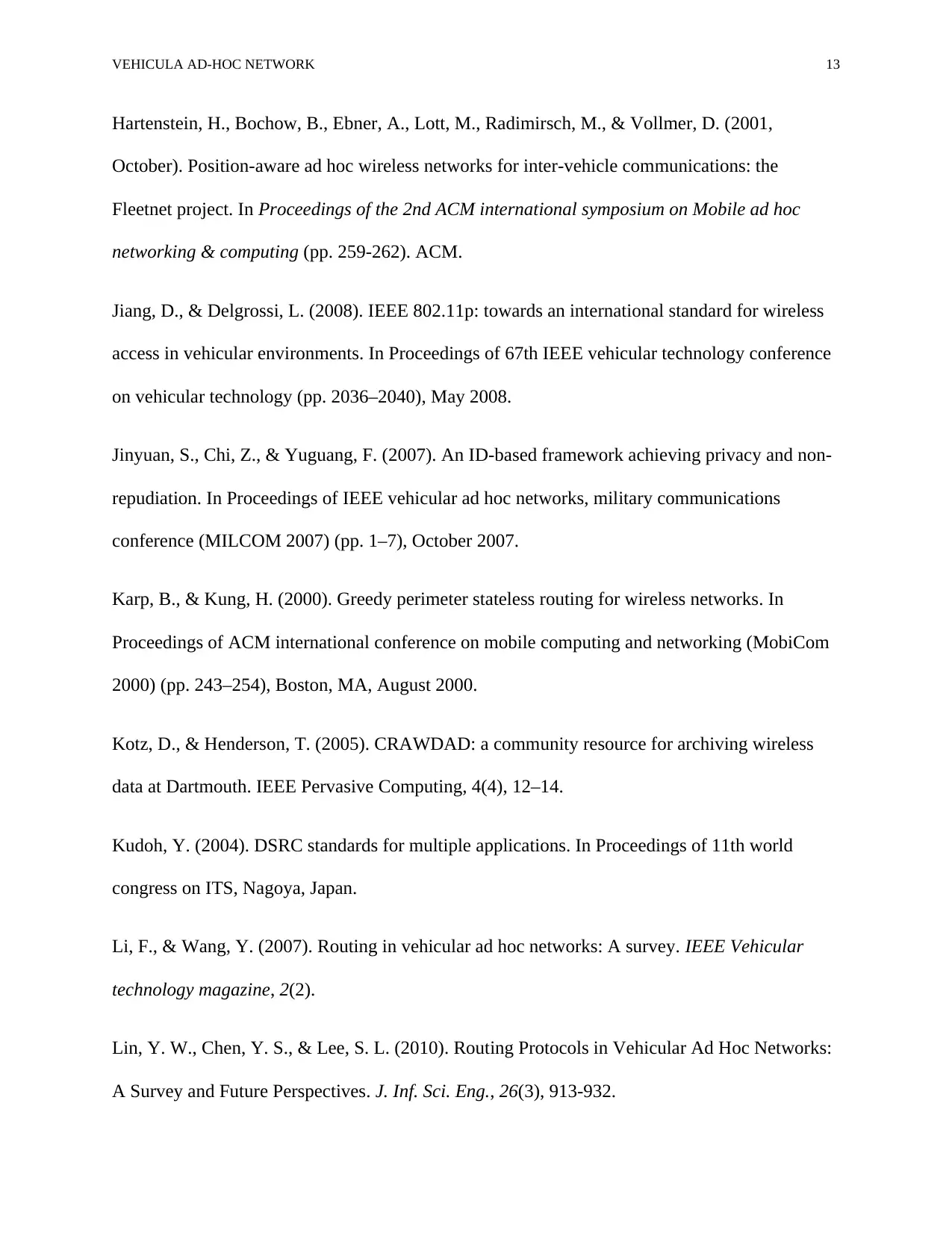
VEHICULA AD-HOC NETWORK 13
Hartenstein, H., Bochow, B., Ebner, A., Lott, M., Radimirsch, M., & Vollmer, D. (2001,
October). Position-aware ad hoc wireless networks for inter-vehicle communications: the
Fleetnet project. In Proceedings of the 2nd ACM international symposium on Mobile ad hoc
networking & computing (pp. 259-262). ACM.
Jiang, D., & Delgrossi, L. (2008). IEEE 802.11p: towards an international standard for wireless
access in vehicular environments. In Proceedings of 67th IEEE vehicular technology conference
on vehicular technology (pp. 2036–2040), May 2008.
Jinyuan, S., Chi, Z., & Yuguang, F. (2007). An ID-based framework achieving privacy and non-
repudiation. In Proceedings of IEEE vehicular ad hoc networks, military communications
conference (MILCOM 2007) (pp. 1–7), October 2007.
Karp, B., & Kung, H. (2000). Greedy perimeter stateless routing for wireless networks. In
Proceedings of ACM international conference on mobile computing and networking (MobiCom
2000) (pp. 243–254), Boston, MA, August 2000.
Kotz, D., & Henderson, T. (2005). CRAWDAD: a community resource for archiving wireless
data at Dartmouth. IEEE Pervasive Computing, 4(4), 12–14.
Kudoh, Y. (2004). DSRC standards for multiple applications. In Proceedings of 11th world
congress on ITS, Nagoya, Japan.
Li, F., & Wang, Y. (2007). Routing in vehicular ad hoc networks: A survey. IEEE Vehicular
technology magazine, 2(2).
Lin, Y. W., Chen, Y. S., & Lee, S. L. (2010). Routing Protocols in Vehicular Ad Hoc Networks:
A Survey and Future Perspectives. J. Inf. Sci. Eng., 26(3), 913-932.
Hartenstein, H., Bochow, B., Ebner, A., Lott, M., Radimirsch, M., & Vollmer, D. (2001,
October). Position-aware ad hoc wireless networks for inter-vehicle communications: the
Fleetnet project. In Proceedings of the 2nd ACM international symposium on Mobile ad hoc
networking & computing (pp. 259-262). ACM.
Jiang, D., & Delgrossi, L. (2008). IEEE 802.11p: towards an international standard for wireless
access in vehicular environments. In Proceedings of 67th IEEE vehicular technology conference
on vehicular technology (pp. 2036–2040), May 2008.
Jinyuan, S., Chi, Z., & Yuguang, F. (2007). An ID-based framework achieving privacy and non-
repudiation. In Proceedings of IEEE vehicular ad hoc networks, military communications
conference (MILCOM 2007) (pp. 1–7), October 2007.
Karp, B., & Kung, H. (2000). Greedy perimeter stateless routing for wireless networks. In
Proceedings of ACM international conference on mobile computing and networking (MobiCom
2000) (pp. 243–254), Boston, MA, August 2000.
Kotz, D., & Henderson, T. (2005). CRAWDAD: a community resource for archiving wireless
data at Dartmouth. IEEE Pervasive Computing, 4(4), 12–14.
Kudoh, Y. (2004). DSRC standards for multiple applications. In Proceedings of 11th world
congress on ITS, Nagoya, Japan.
Li, F., & Wang, Y. (2007). Routing in vehicular ad hoc networks: A survey. IEEE Vehicular
technology magazine, 2(2).
Lin, Y. W., Chen, Y. S., & Lee, S. L. (2010). Routing Protocols in Vehicular Ad Hoc Networks:
A Survey and Future Perspectives. J. Inf. Sci. Eng., 26(3), 913-932.

VEHICULA AD-HOC NETWORK 14
Liu, B., Khorashadi, B., Du, H., Ghosal, D., Chuah, C., & Zhang, M. (2009). VGSim: an
integrated networking and microscopic vehicular mobility simulation platform—[Topics in
automotive networking]. IEEE Communications Magazine, 47(5), 134–141.
Mohandas, B., & Liscano, R. (2008). IP address configuration in VANET using centralized
DHCP. In Proceedings of 33rd IEEE conference on local computer networks, Montreal, Canada,
October 2008.
Raya, M., & Hubaux, J. (2005). The security of vehicular ad hoc networks. In Proceedings of the
3rd ACM workshop on security of ad hoc and sensor networks (SASN 2005) (pp. 1–11),
Alexandria, VA.
Raya, M., Papadimitratos, P., & Hubaux, J. (2006). Securing vehicular communications. IEEE
Wireless Communications, Special Issue on Inter-Vehicular Communications, 13(5), 8–15.
Reichardt, D., et al. (2002). CARTALK 2000 safe and comfortable driving based upon inter-
vehicle-communication. In Proceedings of IEEE intelligent vehicle symposium (Vol. 2, pp. 17–
21), June 2002.
Shulman, M., & Deering, R. (2007). Vehicle safety communications in the United States. US
Department of Transportation, National Highway Traffic and Safety Administration (NHTSA).
Sun, S., Kim, J., Jung, Y., & Kim, K. (2009). Zone-based greedy perimeter stateless routing for
VANET. In Proceedings of international conference on information networking, ICOIN 2009
(pp. 1–3), January 2009.
Liu, B., Khorashadi, B., Du, H., Ghosal, D., Chuah, C., & Zhang, M. (2009). VGSim: an
integrated networking and microscopic vehicular mobility simulation platform—[Topics in
automotive networking]. IEEE Communications Magazine, 47(5), 134–141.
Mohandas, B., & Liscano, R. (2008). IP address configuration in VANET using centralized
DHCP. In Proceedings of 33rd IEEE conference on local computer networks, Montreal, Canada,
October 2008.
Raya, M., & Hubaux, J. (2005). The security of vehicular ad hoc networks. In Proceedings of the
3rd ACM workshop on security of ad hoc and sensor networks (SASN 2005) (pp. 1–11),
Alexandria, VA.
Raya, M., Papadimitratos, P., & Hubaux, J. (2006). Securing vehicular communications. IEEE
Wireless Communications, Special Issue on Inter-Vehicular Communications, 13(5), 8–15.
Reichardt, D., et al. (2002). CARTALK 2000 safe and comfortable driving based upon inter-
vehicle-communication. In Proceedings of IEEE intelligent vehicle symposium (Vol. 2, pp. 17–
21), June 2002.
Shulman, M., & Deering, R. (2007). Vehicle safety communications in the United States. US
Department of Transportation, National Highway Traffic and Safety Administration (NHTSA).
Sun, S., Kim, J., Jung, Y., & Kim, K. (2009). Zone-based greedy perimeter stateless routing for
VANET. In Proceedings of international conference on information networking, ICOIN 2009
(pp. 1–3), January 2009.
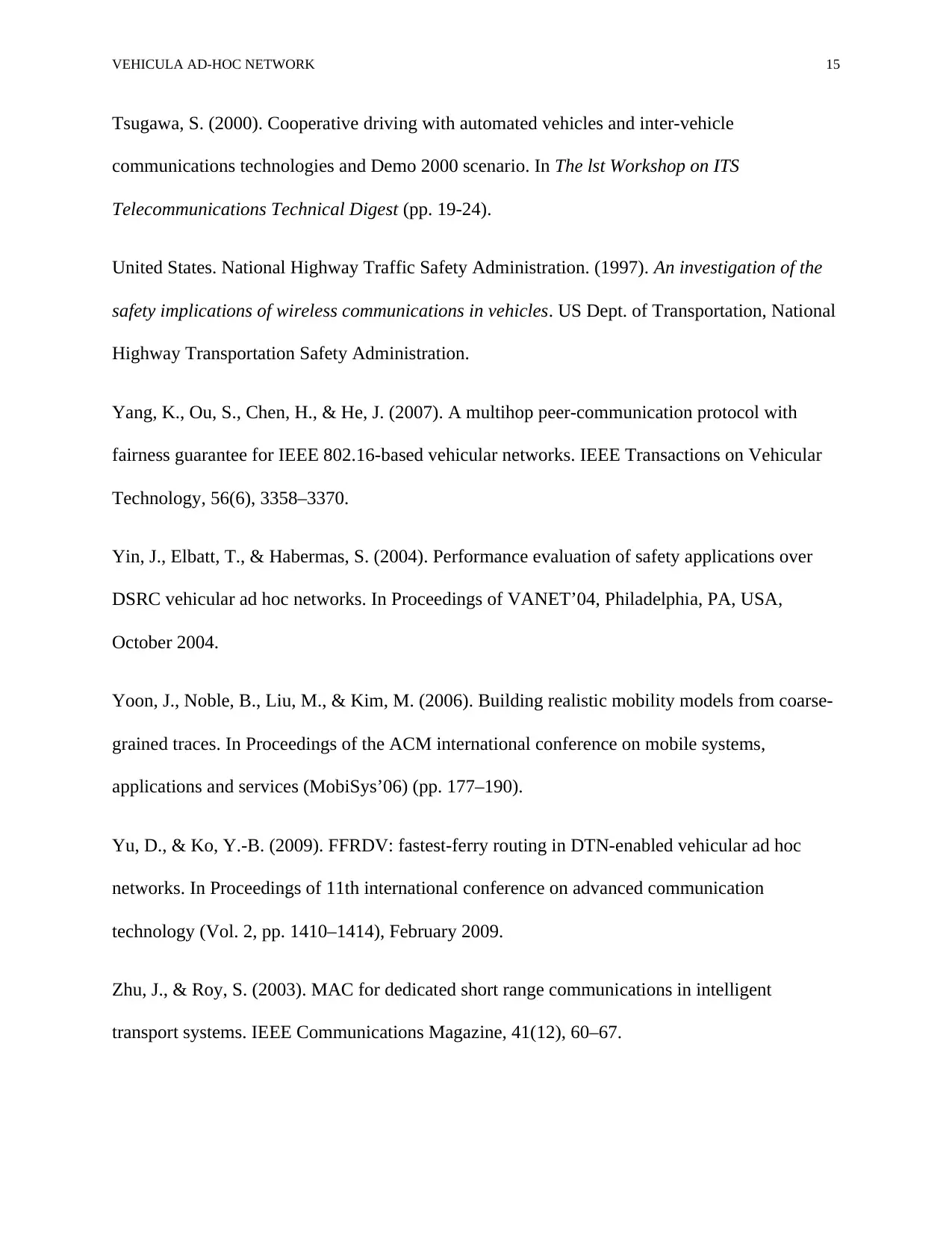
VEHICULA AD-HOC NETWORK 15
Tsugawa, S. (2000). Cooperative driving with automated vehicles and inter-vehicle
communications technologies and Demo 2000 scenario. In The lst Workshop on ITS
Telecommunications Technical Digest (pp. 19-24).
United States. National Highway Traffic Safety Administration. (1997). An investigation of the
safety implications of wireless communications in vehicles. US Dept. of Transportation, National
Highway Transportation Safety Administration.
Yang, K., Ou, S., Chen, H., & He, J. (2007). A multihop peer-communication protocol with
fairness guarantee for IEEE 802.16-based vehicular networks. IEEE Transactions on Vehicular
Technology, 56(6), 3358–3370.
Yin, J., Elbatt, T., & Habermas, S. (2004). Performance evaluation of safety applications over
DSRC vehicular ad hoc networks. In Proceedings of VANET’04, Philadelphia, PA, USA,
October 2004.
Yoon, J., Noble, B., Liu, M., & Kim, M. (2006). Building realistic mobility models from coarse-
grained traces. In Proceedings of the ACM international conference on mobile systems,
applications and services (MobiSys’06) (pp. 177–190).
Yu, D., & Ko, Y.-B. (2009). FFRDV: fastest-ferry routing in DTN-enabled vehicular ad hoc
networks. In Proceedings of 11th international conference on advanced communication
technology (Vol. 2, pp. 1410–1414), February 2009.
Zhu, J., & Roy, S. (2003). MAC for dedicated short range communications in intelligent
transport systems. IEEE Communications Magazine, 41(12), 60–67.
Tsugawa, S. (2000). Cooperative driving with automated vehicles and inter-vehicle
communications technologies and Demo 2000 scenario. In The lst Workshop on ITS
Telecommunications Technical Digest (pp. 19-24).
United States. National Highway Traffic Safety Administration. (1997). An investigation of the
safety implications of wireless communications in vehicles. US Dept. of Transportation, National
Highway Transportation Safety Administration.
Yang, K., Ou, S., Chen, H., & He, J. (2007). A multihop peer-communication protocol with
fairness guarantee for IEEE 802.16-based vehicular networks. IEEE Transactions on Vehicular
Technology, 56(6), 3358–3370.
Yin, J., Elbatt, T., & Habermas, S. (2004). Performance evaluation of safety applications over
DSRC vehicular ad hoc networks. In Proceedings of VANET’04, Philadelphia, PA, USA,
October 2004.
Yoon, J., Noble, B., Liu, M., & Kim, M. (2006). Building realistic mobility models from coarse-
grained traces. In Proceedings of the ACM international conference on mobile systems,
applications and services (MobiSys’06) (pp. 177–190).
Yu, D., & Ko, Y.-B. (2009). FFRDV: fastest-ferry routing in DTN-enabled vehicular ad hoc
networks. In Proceedings of 11th international conference on advanced communication
technology (Vol. 2, pp. 1410–1414), February 2009.
Zhu, J., & Roy, S. (2003). MAC for dedicated short range communications in intelligent
transport systems. IEEE Communications Magazine, 41(12), 60–67.
1 out of 16
Related Documents
Your All-in-One AI-Powered Toolkit for Academic Success.
+13062052269
info@desklib.com
Available 24*7 on WhatsApp / Email
![[object Object]](/_next/static/media/star-bottom.7253800d.svg)
Unlock your academic potential
© 2024 | Zucol Services PVT LTD | All rights reserved.





